|
|
||||||||||||||||||||
|
|
|
|
| Thu Jan 24, 2008 - 10:20 AM EST - By Andre Kibbe | |
|
|
|
|
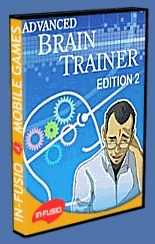
Whether standing in box office line or sitting in an airport terminal, the Treo provides endless ways to fill time. Listening to music, watching ripped DVDs, watching mobile TV, and surfing the web are fairly passive activities; and for productivity geeks like myself, who can only review their calendar and To Do list so many times, it’┐Įs clear that some forms of recreation are more productive and fulfilling than others. One way to pass the time usefully is enlisting the Treo to give the brain a workout with the likes of Advanced Brain Trainer.
This article concludes the look at Advanced Brain Trainer I started in my previous review of Edition 1. For the uninitiated, Advanced Brain Trainer Edition 2 is the latest installment of In-Fusio’┐Įs game suite designed to do precisely what its title implies: sharpen mental performance though a series of exercises, in a fashion conceptually similar to Nintendo’┐Įs Brain Age.
Boy, was I wrong. This time around, for completeness, I opted for Dr. Winters (calling her ’┐ĮAnn’┐Į seems out of the question). Hmmm . . . How can I describe Dr. Winters? Polite discourse prevents a gentleman from using the first noun that comes to mind, so let’┐Įs just say her personality is not inconsistent with that of a typical grad school prof. ’┐ĮThis is bad. A chimp would have done better,’┐Į she said of my typical score. When I finally rose through the ranks to unlock Arcade Mode, she remained a wet blanket. ’┐ĮI don’┐Įt like the name arcade. This is not something to do for fun. This is a serious and demanding challenge.’┐Į
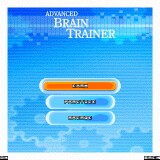
Arcade Mode is a bonus round, basically a sped-up version of Exam Mode, but with less latitude for making mistakes. Also available is Practice Mode. Unlike Exam Mode, which administers a maximum of one completed exam per day, the games in Practice Mode have no such limit, though Practice Mode scores aren’┐Įt retained from session to session.
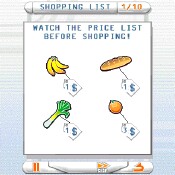
Shopping List is a very well-designed game, as simultaneously entertaining and challenging as any game in this genre should be. The first screen displays four grocery products, each with a price tag. The second screen shows several of the products, without the price tags, rolling by on a checkout conveyor into a shopping cart. The third screen poses one of two types of recall questions: the total cost of the items in the shopping cart, based on their price tags, or the total number of items for one particular product (e.g. 2 cartons of milk).
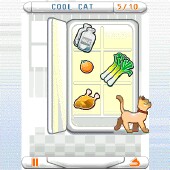
Cool Cat is deceptively cute. You learn very quickly to ignore its charms and concentrate on the game. The first screen shows a cat walking across a kitchen floor, past an open refrigerator with several food items. As the cat passes, the fridge door slams shut, scooping the cat inside; then the fridge convulses in sympathy with its restless feline captive. When the door opens and the cat walks away, the food contents of the fridge may or may not have changed, depending on the cat’┐Įs activity and appetite. The second screen asks the player one of three questions: how many total items are left, how many items of a particular food are left, or how many foods have changed position.
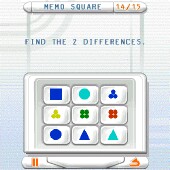
Memo Square is a progressively difficult test of pattern memory, not unlike Edition 1’┐Įs Four Aces. The first screen presents a 3 x 3 grid of several colored squares, circles, triangles, clusters of 3 circles and clusters of 4. The second screen asks the player to identify either the position(s) of a particular shape on a blank grid, or changes between shapes on the previous screen and a slightly modified version currently displayed. This is the most challenging game of this series, though the least entertaining. Since there’┐Įs no way of knowing ahead of time which combination of shapes and colors will be tested, there’┐Įs plenty of information the player has to hold in mental RAM.
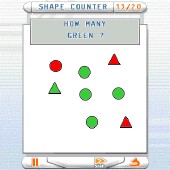
Shape Counter might have been a worthwhile game, had it worked properly. I’┐Įll describe how it was probably designed to work, then how it doesn’┐Įt. The first screen displays an assortment of stars, squares, circles and triangles scattered on a white background. Some of these shapes are stationary, some are moving and some are blinking. In a functional version, the second screen would ask the player to identify one of the following: how many total shapes are of a certain color, how many of a particular shape are a certain color, how many shapes are in a particular state (static, blinking, moving), or how many of the latter are of a certain color.
Unfortunately a bug in the app merges the two stages, overlaying the question on the same field as the shapes. In other words, you’┐Įre seeing the question and answer simultaneously. You have to tap on the question field above the shapes to advance to the second screen with the answer keypad. That’┐Įs great if you’┐Įre interested in scoring free points (if it results in less contempt from Dr. Winters, I’┐Įm all for it), it’┐Įs not much of a game.
Both editions heavily emphasize developing one’┐Įs short-term memory at the expense of other aspects of the mind. ABT’┐Įs exclusively graphical approach doesn’┐Įt facilitate more intricate reasoning challenges that are better suited to word problems.
Overall, I preferred Edition 1, which is broader in the mental faculties it trains’┐Įit had a couple of calculation modules: Speed Count and Color Algebra. Edition 2 has fewer games, especially since Shape Counter is dysfunctional. But I still enjoyed 3 of the 4 games immensely, and for the price, it’┐Įs a worthwhile addition to Edition 1.
|
|
||||||||||||||||||||
|
Copyright 1999-2016 TreoCentral. All rights reserved :
Terms of Use : Privacy Policy
TREO and TreoCentral are trademarks or registered trademarks of palm, Inc. in the United States and other countries;
the TreoCentral mark and domain name are used under license from palm, Inc.
The views expressed on this website are solely those of the proprietor, or
contributors to the site, and do not necessarily reflect the views of palm, Inc.
Read Merciful by Casey Adolfsson